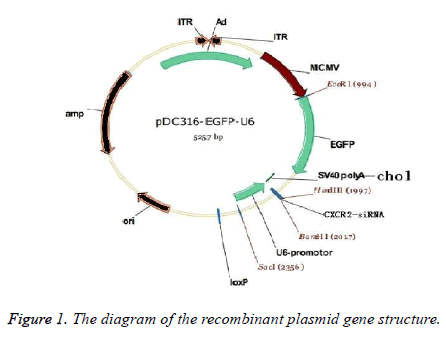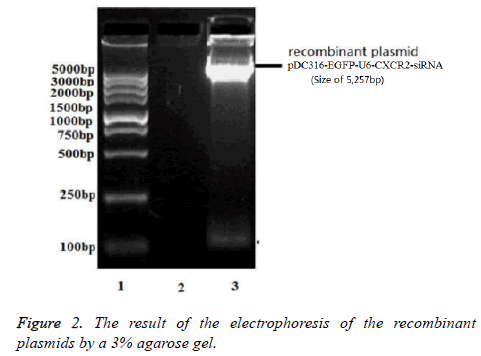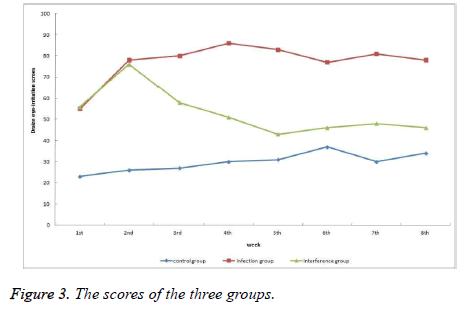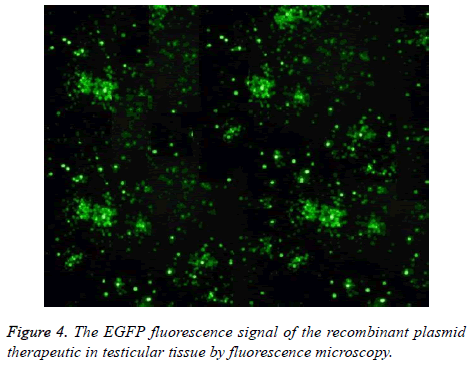ISSN: 0970-938X (Print) | 0976-1683 (Electronic)
Biomedical Research
An International Journal of Medical Sciences
Research Article - Biomedical Research (2017) Volume 28, Issue 7
Constructed recombinant plasmid with CXCR2-siRNA interventions on syphilis animal experiments
1Department of Key Laboratory, the 2nd Affiliated Hospital of Kunming Medical University, the 374th Dian Mian Road, Kunming, Yunnan Province, PR China
2Department of Abdominal Tumor Surgery, the 3rd Affiliated Hospital of Kunming Medical University, the 519th, Kunzhou Road, Kunming, Yunnan Province, PR China
3Department of Division of Science and Technology, Kunming Medical University, PR China
- *Corresponding Author:
- Zhang Liang
Department of Division of Science and Technology
Kunming Medical University, PR China
Accepted date: December 1, 2016
Objective: To study the construction and modifications of siRNA with CXCR2 (chemokine receptor expression 2) and to evaluate its treatment effect in a rabbit animal model infected with syphilis on the testicle and eye.
Methods: The synthetic CXCR2-siRNA was linked with the pDC316-EGFP-U6 plasmid by ligase, and then this reconstruction plasmid was modified with cholesterol. After establishment of the animal model by Treponema pallidum (TP) for rabbits’ testicles and eyes, intervention by the plasmid with CXCR2- siRNA was utilized and its effects were evaluated.
Results: The recombinant plasmid was detected by agarose gel electrophoresis, and it was the right size and concentration of 285 ng/μl by UV spectrophotometer. After 28 days of treatment, there was no difference between the control group and empty plasmid control group in its treatment effect (P>0.05). However, the effect of the recombinant plasmid was obvious, with a statistical significance (P<0.01). There were significant differences between the three groups in chancre, testis swelling, orchitis, fur damage, lymphadenitis and TP in the testis by microscopy. However, there was no difference in the rabbits’ serum syphilis antibody level by the Treponema pallidum Particle Hemagglutination Assay (TPHA). EGFP (Enhanced Green Fluorescent Protein) was observed by fluorescence microscopy, and the cellular ratio with the green fluorescent protein was 10%. There was a high efficiency of transfection for the recombinant plasmid with CXCR2-siRNA.
Conclusion: The modified recombinant plasmid clearly interfered with the in vivo replication of syphilis.
Keywords
siRNA, CXCR2, Syphilis, Intervention, Animal model
Abbreviations
CXCR2: Chemokine Receptor Expression 2; TP: Treponema pallidum; TPHA: Treponema pallidum particle Hemagglutination Assay; EGFP: Enhanced Green Fluorescent Protein; RNAi: Ribonucleic Acid Interference; HIV: Human Immunodeficiency Virus.
Introduction
Chemokine receptor expression 2 (CXCR2) is a member of the associated G protein receptor super family, with an affinity to IL-8, and a subfamily member of the chemokines CXC [1,2]. Recent studies show that CXCR2 plays an important role in syphilis disease progression [3,4]. Associated chemokines are presented in the skin and mucosal tissue, eye tissue, nerve and joint tissue. CXCR2 is closely related to the development of syphilis.
Ribonucleic Acid interference (RNAi) is an ancient and widespread phenomenon in biological evolution. RNAi is mediated by siRNA and involves the Dicer enzyme to silence target genes specifically and efficiently [5-7]. In 2001, it was first confirmed that RNAi mechanisms exist in mammalian organisms, which are induced by 21 to 25 nucleotides [6,7]. siRNA can be introduced into mammalian cells via different transfection techniques, resulting in the inhibited expression of specific genes [6]. RNAi has become a new effective method to study drug interventions.
Treponema pallidum subsp. pallidum is the causative agent of syphilis, which is a sexually transmitted disease that is characterized by widespread tissue dissemination and chronic infection [8]. A significantly high incidence of syphilis has been reported in several countries, including China, and there is an urgent need for the development of efficacious formulations against Treponema pallidum (TP).
Syphilis is most commonly spread through sexual activity. It may also be transmitted from mother to baby during pregnancy or at birth, resulting in congenital syphilis. Other human diseases caused by related Treponema pallidum (TP) include yaws (subspecies pertenue), pinta (subspecies carateum), and bejel (subspecies endemicum). The diagnosis is usually made through a blood test, and the bacteria can also be detected using dark field microscopy. The Centers for Disease Control recommends that all pregnant women be tested [8,9].
In 2013, syphilis infected approximately 315,000 people. During 2010, it caused approximately 113,000 deaths, which were down from 202,000 in 1990. After decreasing dramatically with the availability of penicillin in the 1940s, the rates of infection have increased since the turn of the millennium in many countries, often in combination with Human Immunodeficiency Virus (HIV) [3,5,10]. This is believed to be partly due to increased promiscuity, prostitution, decreasing use of condoms, and unsafe sexual practices among men who have sex with men. In 2015, Cuba became the first country in the world to eliminate the mother-to-child transmission of syphilis.
CXCR2-siRNA might be a major breakthrough in the field of formulations with several advantages over traditional medicine. Animal model studies of TP have not been reported elsewhere, but our previous finding describes the development of siRNA intervention TP.
Materials and Methods
Construction of interference vector
Using the software siRNA Target Finder (Ambion, USA), the primers were designed according to the human CXCR2 gene sequence from GenBank. The sequence of the CXCR2-siRNA was as: Sense 5' GAACAAAUUUACAGAGACAUU3';Antisense 3' UUCUUGUUUAAAUGUCUCUGU (5'-P) 5'.
Simultaneously, we introduced endonuclease sites in these primers as: Sense 5’ AAGCTT3’; Antisense 3' GGATCC5'. The primers were synthesized by Shanghai Biological Technology Co., Ltd.
Use of vector
The shuttle plasmid pDC316-EGFP-U6, derived from adenoviral vectors, was purchased from Beijing Benyuan Gene Technology Co., Ltd and was composed of the human U6 promoter and expressed EGFP. Digestion was performed by restriction endonuclease BamHI located at 2017 and HindIII located at 1997.
Enzyme-linked reaction: The system was composed of CXCR2-siRNA, 2 μl (weight as 200 ng); Vector DN (pDC316- EGFP-U6), 1 μl (weight as 50 ng); H2O, 2 μl and Ligation Solution 1.5 μl. These were incubated at 16°C for 10 hours. An enzyme-linked reaction kit was purchased from TaKaRa.
Transformation into E. coli
After heat shock at 42°C for 90 seconds in a CaCl2 solution, the competent cells were transformed in to E. coli JM109 Competent Cells (TaKaRa Code No. D9052) following the instructions and were then painted on plates of LB medium. The monoclonal colonies that were ampicillin-resistant positive were selected after 16 hours of culturing at 4°C. According to the sequencing results of the recombinant plasmid, we verified that the plasmid contained the purpose gene of CXCR2-siRNA and named it pDC316-EGFP-U6- CXCR2-siRNA. Then, we mixed the bacteria with glycerol and stored it at-80°C.
Mass production of recombinant plasmid
The bacteria were cultured with recombinant plasmid at 37°C for 18 hours. The QIAGEN plasmid plus Giga kit (Germany) was used to extract a mass production of the plasmid. The concentration of the plasmid and the residue protein interference were detected. Gel electrophoresis and gel recovery were used to remove deoxyribonucleic acid impurities.
Cholesterol modification
By means of pyrrolidine, as a linking agent, cholesterol was connected on the SV40 ployA site of the recombinant plasmid, which was named chol-pDC316-EGFP-U6-CXCR2-siRNA. Figure 1 shows the structure of this plasmid, and the synthesis process was performed by Shanghai Advanced Vehicle Technology L.T.D. Co. (China). The liposomes were also purchased from this company.
Strain source
The strains of Treponema pallidum were from the department of STD prevention and control, the National Center for AIDS/STD Control and Prevention, Chinese CDC. These were puncture fluids from the lymph nodes of sclerolymphadenitis syphilitica patients who were stored in liquid nitrogen. Fifty-eight of the 400 cases with the nichols strain were selected in this study.
Rabbit sources
Thirty infant male rabbits that were 5 weeks old were purchased from Beijing BioMerieux, and they were randomly divided into 3 groups, as the control group, the intervention group and the infection group. The rabbits were fed in strict sterile laminar flow sterile animal separate rooms, with a room temperature of 25°C and an air humidity of 50%.
Animal infection experiment
The mixture stock solution of the lymph puncture was taken from 58 sclerolymphadenitis syphilitica patients to infect the rabbits’ eyelids and testis. All of the attack experiments were conducted only once. Experiment for the eyelid: 0.1 ml of the TP mixture was dropped in one side of every rabbits’ eye for the intervention and infection groups, and it was replaced with PBS for the control group. The other side was a blank control. The eyelids were closed for 3 seconds after the infection to ensure effective TP infection. Experiment for the testis: After shearing the testis hair and applying a stepwise iodine and alcohol disinfection, 0.2 ml of the TP mixture was dropped into the rabbits’ bilateral testis for the intervention and infection groups, and it was replaced with PBS for the control group.
Intervention experiments by the modified recombinant plasmids
A spectrophotometer was used to calculate the concentration of the modified recombinant plasmids (chol-pDC316-EGFP-U6- CXCR2-siRNA) according to the OD value by the formula 1 OD=50 μg/ml. After 72 hours of the TP infection experiment, the modified recombinant plasmids were injected into each of the control and intervention rabbit groups, with a 0.1 mg injection dose. The methods of the intervention were the same as the methods of infection.
A medical observation was performed from 1 to 7 weeks after the infection. According to the Draize eye-irritation score sheet, the extent of loss was assessed. The degree of swelling of the testis, the migration damage and hard chancre were observed. In the seventh week, the TP content was detected within the organization of the eyelid and testis, and the syphilis antibody levels were detected.
Statistical analysis of data
All of the data are represented as the mean ± SD (͞x ± s) of three or more independent experiments. If the data were homogenous, an analysis of variance, Student-Newman-Keulsa and Pearson's correlation were used. If the data are not homogenous, Kruskal-Wallis and Games-Howell tests, as well as a Spearman’s correlation analysis, were used. All of the analyses were carried out using the SPSS 19.0 software (SPSS Inc., Chicago, IL, USA). Values less than 0.05 were considered to be statistically significant.
This study was carried out in strict accordance with the recommendations in the Guide for the Care and Use of Laboratory Animals of the National Institutes of Health. The protocol was approved by the Committee on the Ethics of Animal Experiments of the Kunming Medical University (Permit Number: KMUA201409-37285). All of the surgeries were performed under sodium pentobarbital anesthesia, and all efforts were made to minimize suffering.
Results
Identification of the recombinant plasmid
The results of the electrophoresis of the recombinant plasmids by a 3% agarose gel are shown in Figure 2. It was at correct size (5,257 bp), with a high concentration of supercoiled plasmid. After sequencing, there were no base mutations or deletions in the recombinant plasmid pDC316-EGFP-U6- CXCR2-siRNA.
Determined concentration of the modified recombinant plasmids
By means of a cholesterol modification, the concentration of the modified recombinant plasmids was 285 ng/μl by UV spectrophotometer.
Constitution monitoring of the rabbit experiments
According to the Draize eye-irritation score sheet, every week, the score of eye injury severity was determined. By 7 weeks of investigation, the score of the control group showed little change, from 23 to 37, which indicated that the recombinant plasmids were under drug safety and did not cause eye damage. The eye irritation was manageable. Although the score of the infection group also showed little change, from 78 to 86, they were higher scores. The TP caused significant eye damage, and its harm did not improve until the drug intervention. As for the score of the interference group, which was from 76 to 43, there was a decline in the peak after interference with the recombinant plasmids. The significant decreasing trend occurred in the third week. These results showed that the recombinant plasmid interfered with the syphilis in vivo replication. Treatment of primary syphilis was effective. The scores of three groups are shown in Figure 3. We investigated the changes in the testicular damage as shown in Table 1. As described, there were significant differences between the three groups in chancre, testis swelling, orchitis, fur damage, lymphadenitis and TP in the testis by microscopy. However, there was no difference in rabbit’s serum syphilis antibody level by a Treponema pallidum particle Hemagglutination Assay (TPHA).
| Items of investigation | Groups | X2 | P | |||
|---|---|---|---|---|---|---|
| Infection group | Interference group | Control group | ||||
| Chancre | Yes | 9 | 3 | 0 | 17.5 | p<0.01 |
| No | 1 | 7 | 10 | |||
| Testis swelling or Orchitis | Yes | 10 | 4 | 0 | 20.36 | p<0.01 |
| No | 0 | 6 | 10 | |||
| Fur damage | Yes | 8 | 2 | 0 | 15.6 | p<0.01 |
| No | 2 | 8 | 10 | |||
| Lymphadenitis | Yes | 7 | 3 | 0 | 11.1 | p<0.01 |
| No | 3 | 7 | 10 | |||
| TP in eyelid by Microscopy | Yes | 7 | 0 | 0 | 18.26 | p<0.01 |
| No | 3 | 10 | 10 | |||
| TP in testis by Microscopy | Yes | 8 | 0 | 0 | 21.82 | p<0.01 |
| No | 2 | 10 | 10 | |||
Table 1. The investigation of testicular damage between the three groups.
The detected EGFP fluorescence signal after interference
After interference with the recombinant plasmid, the EGFP fluorescence signal was tested by means of a 10% formalinfixed testicular tissue. The EGFP was located in the plasmid pDC316-EGFP-U6. By fluorescence microscopy, we observed an enhanced green fluorescent signal in the tissue. These data indicated that the recombinant plasmid transfected into the cells successfully. This result is preformatted in Figure 4.
Discussion and Conclusion
In 2013, the syphilis incidence was 64.41 per 100,000, with a reported 10,757 cases in the Chinese mainland. The average annual growth rate of the syphilis incidence was 49.2% from 2009 to 2013 [10,11]. In developing countries, the distinctive feature of syphilis is that high-risk groups have a high morbidity [11]. Through investigation, the TP positive rate was 30.6%, and it was 31.2% within the MSM population. In some areas, the pregnant women population showed an 11.3% positive rate. The syphilis epidemic showed a high trend in the Chinese mainland, with risk factors. Another serious problem is that syphilis has complications with other STDs, AIDS and gynaecologic oncology [12,13]. Our department focuses on cervical cancer research, and we tried to use a siRNA interference technique to treat syphilis and cervical cancer. In this study, we made meaningful results in this study. siRNA is an intermediate in the process of RNA interference and is usually a 20 to 25 nucleotide long double-stranded RNA [2,3]. By reference to the human chemokine receptor CXCR2 gene sequence, we used siRNA to interfere with the testis cells expressing CXCR2, with the purpose of preventing the replication and infection of Treponema pallidum. The CXCR2 siRNA was cloned into the shuttle plasmid pDC316-EGFP-U6. This plasmid has a human U6 promoter, the reporter gene EGFP and the modified processing site SV40ployA. siRNA is introduced into cells via a variety of different transfection techniques [14]. In this study, the recombinant plasmid was transduced into the rabbits’ cells by packaging with the liposome after the cholesterol modification. Because of the larger nuclease in tissue and blood, a siRNA drug might be rapidly degraded and be a poor treatment. It was important to maintain the drug stability of the recombinant plasmid. In this study, by means of the linking agent, pyrrolidine, cholesterol was linked on the SV40 ployA site of the recombinant plasmid. The final product was chol-pDC316-EGFP-U6-CXCR2- siRNA. The recombinant plasmid treatment group had a statistically significant effect in the rabbits with transplanted syphilis. Although penicillin, in the treatment of syphilis, is effective, this is complex in regard to HIV infection or complications with cervical cancer [15-17]. In our previous study, CXCR2 (chemokine receptor expression 2) was highly expressed in these situations. Thus, the significance of this study was to explore a variety of drugs for treatment with HIV or cervical cancer. The animal experiments were preliminary experiments to evaluate the safety and efficacy of the drugs and avoid drug-resistant species. The modified recombinant plasmid interfered with the in vivo syphilis replication process. There were significant differences between the three groups in chancre, testis swelling, orchitis, fur damage, lymphadenitis and TP in the testis by microscopy. The treatment for primary syphilis was effective. This drug has wide application treatments for complications of syphilis.
Competing Interests
The authors declare that they have no competing interests.
Authors’ Contributions
Xia Cao made substantial contributions to the conception and design and analysed the data. Jun Ma carried out the molecular genetic studies, participated in the sequence alignment and drafted the manuscript. Zhang Liang wrote the manuscript and critically revised it for important intellectual content.
Availability of Data and Materials
All of the datasets from which the conclusions of the manuscript rely are to be either deposited in publicly available repositories (where available and appropriate) or presented in the main paper or the additional supporting files in a machinereadable format (such as spread sheets rather than PDFs) whenever possible.
Acknowledgements
This study was supported by the Joint Fund of the Yunnan Province (2013FB150, 2013FB107) and the Yunnan Science and Technology Talent Reserve (2015HB041).
References
- Dwyer MP, Yu Y. CXCR2 modulators: a patent review (2009-2013). Expert Opin Ther Pat 2014; 24: 519-534.
- Gifford AM, Chalmers JD. The role of neutrophils in cystic fibrosis. Curr Opin Hematol 2014; 21: 16-22.
- Marro BS, Hosking MP, Lane TE. CXCR2 signaling and host defense following coronavirus-induced encephalomyelitis. Future Virol 2012; 7: 349-359.
- Stadtmann A, Zarbock A. CXCR2: From bench to bedside. Front Immunol 2012; 3: 263.
- Claycomb JM. Ancient endo-siRNA pathways reveal new tricks. Curr Biol 2014; 24: R703-715.
- Hope MJ. Enhancing siRNA delivery by employing lipid nanoparticles. Ther Deliv 2014; 5: 663-673.
- Kaur IP, Chopra K, Rishi P, Puri S, Sharma G. Small RNAs: the qualified candidates for gene manipulation in diverse clinical pathologies. Crit Rev Ther Drug Carrier Syst 2014; 31: 305-329.
- Zhao F, Zhang X, Liu S. Assessment of the immune responses to Treponema pallidum Gpd DNA vaccine adjuvanted with IL-2 and chitosan nanoparticles before and after Treponema pallidum challenge in rabbits. Sci China Life Sci 2013; 56: 174-180.
- McGill MA, Edmondson DG, Carroll JA, Cook RG, Orkiszewski RS. Characterization and serologic analysis of the Treponema pallidum proteome. Infect Immun 2010; 78: 2631-2643.
- Guo W, Wu ZY, Song AJ. Impact of HIV/sexually transmitted infection testing on risky sexual behaviors among men who have sex with men in Langfang, China. Chin Med J (Engl) 2013; 126: 1257-1263.
- Liu H, Rodes B, George R, Steiner B. Molecular characterization and analysis of a gene encoding the acidic repeat protein (Arp) of Treponema pallidum. J Med Microbiol 2007; 56: 715-721.
- Park KH, Lee MS, Hong IK, Sung JY, Choi SH. Bone involvement in secondary syphilis: a case report and systematic review of the literature. Sex Transm Dis 2014; 41: 532-537.
- Noy M, Rayment M, Sullivan A, Nelson M. The utility of cerebrospinal fluid analysis in the investigation and treatment of neurosyphilis. Sex Transm Infect 2014; 90: 451.
- Hertzer KM, Donald GW, Hines OJ. CXCR2: a target for pancreatic cancer treatment? Expert Opin Ther Targets 2013; 17: 667-680.
- Giacani L, Molini B, Godornes C. Quantitative analysis of TPR gene expression in Treponema pallidum isolates: Differences among isolates and correlation with T-cell responsiveness in experimental syphilis. Infect Immun 2014; 75: 104-112.
- Smajs D, Norris SJ, Weinstock GM. Genetic diversity in Treponema pallidum: implications for pathogenesis, evolution and molecular diagnostics of syphilis and yaws. Infect Genet Evol 2012; 12:191-202.
- Dmitriy V, Shevchenko, Timothy J, Sellati, David L. Membrane topology and cellular location of the Treponema pallidum glycerophosphodiester phosphodiesterase (GlpQ) Ortholog. Infect Immun 1999; 67: 2266-2276.



